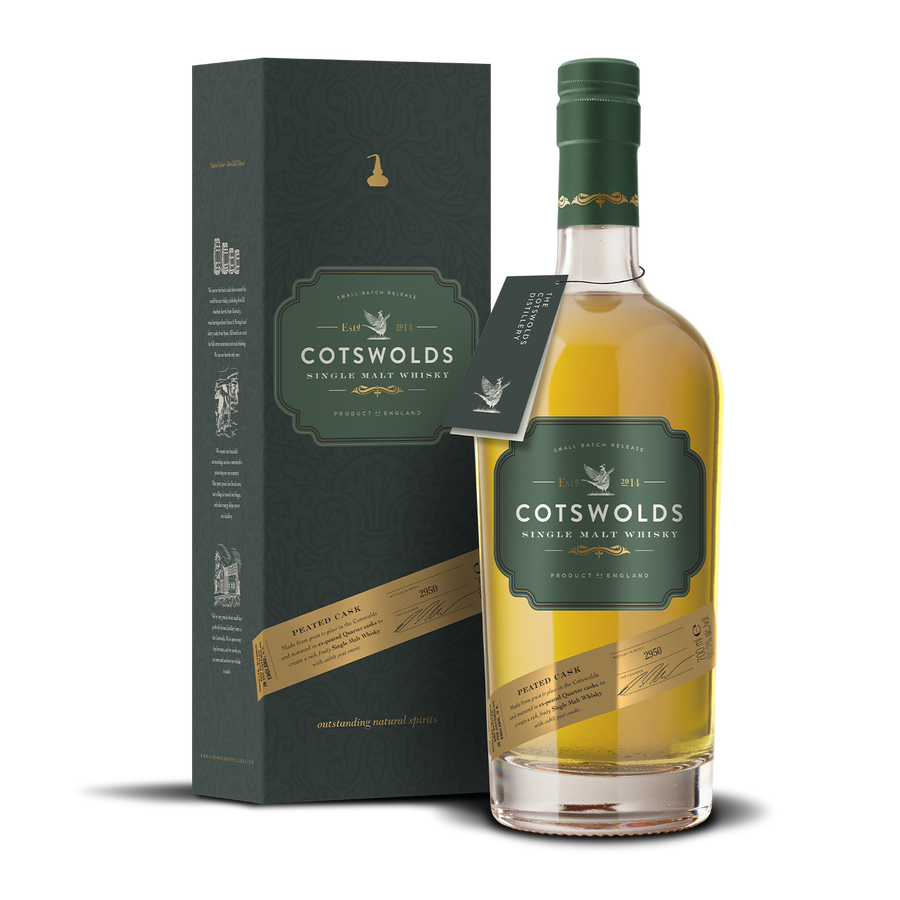Get Hooked on Smoky Whisky – Your First Lightly Peated Single Malt
For many, the flavour of single malt whisky is synonymous with peat. However, there’s more to this fascinating flavour than meets the eye. Beyond the classic peaty influence, whisky can acquire its rich smokiness in several ways, such as using ex-peated casks. Whether you're a seasoned whisky enthusiast, just beginning your journey or looking for the perfect gift, exploring the subtle differences in smoky profiles opens up a world of discovery. Dive into our guide to unravel the complexities of smoke in whisky and find the perfect bottle to ignite your senses.
If you want to get into smoky whisky, this could be the way to do it.
Peated Cask Single Malt whisky offers delicate smoke without overpowering your palate.
From serving guides to food pairings, learn how to make the most of a smoky whisky.
Barrel charring, production and maturation techniques help to create a smoky profile.
The Best Introduction to Peated Whisky
One of the most iconic flavours in the malt whisky world is peat. Peat is an organic material found in soil, it’s naturally high in carbon, so when dried, it becomes an excellent fuel source. Peat has been used in Scotland since the Middle Ages – one of its many uses was to power the kilns used to dry malted barley, a critical stage in single malt whisky production. These peat fires impart a distinctive smokiness onto the base grain, which is retained throughout the fermentation, distillation and maturation processes.
The intense smokiness of peat can be off-putting if you’re just starting to enjoy malt whisky. Some whisky drinkers prefer unpeated malt whisky. If you want to expand into smoky whisky without a bottle that knocks your socks off, you’ve come to the right place.
Cotswolds Single Malt uses premium seasoned oak barrels to create diverse flavour profiles. Lightly peated expressions come from ex-peated barrels, the result is a much more accessible flavour than heavily peated options.

The Smoky Whisky for Non-Peatheads
While popular, a long, smoky finish isn’t for everyone. When starting to drink whisky, you may feel encouraged to try the smoky malts of Islay such as Ardberg, Laphroaig or Bunnahabhain. Don’t let the ric,h pungent aromas of peat put you off; you may need to try a more approachable bottle to ease yourself into the flavour that so distinctively characterises single malt.
If you’re not a peat-head but want to explore the variety of liquid the category has to offer, you could choose a peated cask whisky. Seasoned oak casks add flavours from the contents previously aged in them. In the case of ex-peat casks, the barrels are recycled from the production of peated whisky – they introduce a lovely balance of peat without overbearing smokiness or ashy flavours.
Cotswolds Peated Cask Single Malt Whisky
At the Cotswolds Distillery, we’re all about bold flavours and fruit-forward expressions. Many producers rely on getting all their flavour from peat or from the previous barrel seasoning, such as Sherry casks, for a rich fruity finish. Through long fermentation periods, Cotswolds distillers pack the heart cut with fruity esters and fatty acids, creating ripe and tropical fruit flavours for a sweet smoke profile.

Our flavour-packed base spirit spends its full maturation time in quarter-cask ex-peated barrels to create a light peat level that adds to the complexity of the liquid rather than overpowering its unique profile. The very small batches (quarter casks) allow for more contact with the wood, and the final result offers a higher peat level at a much younger age. The moreish Cotswolds Peated Cask Single Malt is reminiscent of barbequed bananas topped with ice cream.

This peated cask single malt is the perfect option if you’re venturing into peated whisky – lightly smoky without sacrificing depth of flavour. Tickle your tastebuds with Peated Cask Single Malt Whisky.
For something a little more subtle, try the Hearts and Crafts Golden Wold Single Malt Whisky. This limited edition blends whisky from a variety of cask types, including Bourbon barrels, STR red wine and peated casks. This smooth and mellow shows off the rich and fruity character of our single malt spirit. Try a bottle for yourself.

How to Enjoy Smoky Whisky for the First Time
Contrary to what many whisky aficionados will recommend, you may not find your love for peated whisky by trying Laphroaig on your first try. However, trying single malts with diverse flavour profiles helps you find your unique preference and develop an appreciation for each bottle.
Select a mildly peated option, a blend, or a single malt that uses ex-peated casks. Blended single malt often gets a bad reputation for offering inferior quality, but the harmony of flavour achieved in a blend can be as enjoyable as single malt, especially when peated single malts are brought into the mix.
Some mildly peated options include characterful maritime whisk,y Talisker or Loch Lomond, experiment with some popular brands with feedback, or buy whisky miniatures to trial a few different options.
New to peated whisky? Try these options
- Mildly peated single malt
- Blended malt whisky including at least one peated single malt
- Peated cask single malt

Smoky whisky food pairings you haven’t tried
It might seem obvious to pair smoky whisky with something savoury or even smoky, such as flame-grilled steak, charcuterie, cured meats, or aged cheese. Salty, pungent and fatty foods are able to balance out the rich smokiness of the spirit. Seafood and fresh herbs pair well with maritime whisky, such as the smoky malts of Islay or Campbeltown.
Olives are another great accompaniment to smoky and peated whisky – a good quality olive oil marinade and fresh Nocarella olives would go a long way paired with the Peated Cask Single Malt from the Cotswolds Distillery.
Pairing whisky doesn’t have to be difficult, enjoy a glass of peated whisky alongside your favourite crisps – salt and vinegar, cheese and onion or Nice ‘n’ Spicy Niknaks. If you have a sweet tooth, a rich chocolate brownie or a pineapple upside-down cake could do the trick for you.
Our favourite foods to pair with smoky whisky
- Charcuterie and cured meat
- Grilled meat
- Aged cheese
- Herby fish pie
- Olives/olive oil
- Crisps
- Dark chocolate
- Caramelised soft fruit
Smoky whisky cocktails and mixing
You may expect whisky experts to tell you to never mix a smoky single malt. While they are usually enjoyed neat to experience the unique flavour profiles, there are no rules when it comes to drinking whisky. You might find that adding water or ice makes the perfect serve. A Smokey Cokey might do it for you. Once you understand the flavours present in your bottle of whisky, it makes mixing the perfect cocktail easy.
Option 1: Add ice or water
No, adding a splash of water is not sacrilegious like many seem to believe it is. Whisky comes out of the barrel at about 60% ABV, and it’s typically diluted down to around 40% for your enjoyment. The bottle strength is your starting point; if you want to bring the intensity down a notch further, do so.
Ice makes for a refreshing drink and also helps to dilute the spirit. Add whisky stones if you enjoy a cold whisky without uneven dilution.
Option 2: Add a mixer: the iconic Smokey Cokey
Take the Cotswolds Peated Cask Single Malt. It offers tropical fruit, vanilla and sweet smoke; what would pair better than a full-fat Coke? Experiment with your proportions until you get the balance just right. There are so many flavours to combine, vanilla Coke, cherry Coke, peach Fanta, Appletiser and more.
Option 3: Make a Cocktail
Not every cocktail is going to flavour a smoky whisky, but there are definitely some to try if you're new to this category. The first up is a smoky Old Fashioned with brown sugar and bitters – refined, classic and slightly sweet.
Next up is the Godfather. Pairing the vanilla notes from the Cotswolds Peated Cask Single Malt with amaretto creates a delightful experience. Distinct from a traditional Godfather cocktail.
Finally, we couldn’t talk about Cotswolds Single Malt cocktails without mentioning the Pina Colada. Our spirit leans into the tropical fruits perfectly, and a gentle touch of smoke will certainly be something new and exciting that you’ve probably never tried before.
Is there anything other than peat that makes a whisky smoky?
Peat fires are the most common way of introducing smokiness into whisky. However, some other techniques impart toasty, almost burnt flavours without the smoke. In Bourbon production, barrels are toasted and charred to release their flavours, sometimes this can create flavours of burnt caramel or toasted marshmallows. Fermentation, certain yeast strains and distillation techniques can introduce charred or burnt notes, but this isn’t as common.
Finally, some producers experiment with smoking their grains without peat, while others can smoke the barrels during maturation or prior to maturation to add smokiness without distinctive peat.
The difference between peat and smoke
Peated whisky gets its flavour uniquely from peat fires used to dry the malted barley. However, smoky flavours, although rare, can come from elsewhere. Charring, or smoking the barrels or using different fuel sources, can create smokiness without peat.
The best smoky but not peated whiskies
If you’re looking for a smoky whisky without excessive peat, you could choose a peated cask single malt where the barley hasn’t been exposed to peat smoke but only to ex-peated barrels. Alternatively, you could choose a Bourbon-cask whisky that uses charred barrels for a toasted and smoky flavour with no sign of the ultra-savoury peat.
Frequently Asked Questions
Are there any regions known for producing good smoky whisky?
Islay is a special place in Scotland for smoky whiskies. This region, located off the west coast, is known for making some of the most intensely peated Scotch whisky. It has many distilleries that are really good at using peat in whisky production.
What is the best way to develop a taste for peated whisky?
Getting used to the taste of peated single malt whisky is a journey that should happen slowly. Begin with whiskies that are lightly peated. As you get used to the flavour, start trying those with more peat. Don't hesitate to try new things, ask for suggestions, and most importantly, have fun with it!
Is peated whisky better than non-peated?
The choice between peated and non-peated whisky is all about personal taste. Each type has special features and layers of flavour. In the end, the "best" whisky depends on your experience – don't worry about tackling the big hitters straight away.
What to read next
Choosing the best sweet and fruity whisky
Choosing the best whisky with vanilla and caramel notes
Choosing the best spicy whisky
Choosing the best whisky with floral notes

